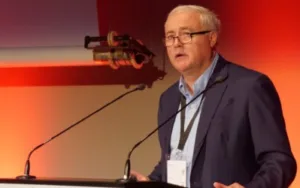Jean-Marc Chery is the Deputy CEO from STMicroelectronics (STM) which has several big facilities in Grenoble that work closely with Leti. STM is working in two big areas – the IoT and Smart Driving. That means Smart Things, Smart Home and Smart Cities, Smart Industry and Smart Driving. Chery went through what STM is doing in each area. He asked delegates to use the Waze app, which makes moving in the traffic in Grenoble much quicker! Chery quoted Audi as saying that 80% of automotive innovation is coming from semiconductors – which is why STM is so involved.
Turning to the semiconductor technology, Chery highlighted STM’s own technology. He started with Silicon Carbide processing which is a good material for automotive and industrial applications. SiC has a bigger bandgap than silicon so can deal with higher fields and voltages to allow smaller devices. There are industrial applications and also smart home and driving/automotive uses. STM can make diodes, Mosfets and chips and will start making devices in the second half of 2017 in Silicon Carbide. The company is the first to be in production with this technology.
 Jean March Chery said that STMicroelectronics has re-aligned around the IoT and autonomous driving. Image:Meko
Jean March Chery said that STMicroelectronics has re-aligned around the IoT and autonomous driving. Image:Meko
Chery then turned to ‘time-of-flight’ technology, which STM markets as FlightSense and sensors have applications in cameras, phones, drones and other devices needing distance measurement. There are applications in A/R to give location information. The firm wants to be a key player in this area and it has a strong position in the area of specialised image sensors.
STM has to focus on getting to market fast, Chery said, and that means a clear need to work with research organisations like Leti.
STM has six product families – automotive ICs, Discrete transistors, power chips, MEMs & sensors, Digital Asics and general purpose controllers. All of these areas have potential for growth.
Chery then focused on IoT and Smart Driving. He identified seven semiconductor building blocks of the IoT
- Processing
- Security
- Sensing and Actuation
- Connectivity
- Conditioning and protection (A/D and D/A)
- Motor control
- Power and energy management
Chery believes that you really need all of these elements to be successful in the IoT. There are many different actors in the business – the semiconductor building blocks are a necessary, but not sufficient condition alone to enable the IoT. STM collaborates with application developers, but also the companies supporting them, for example by offering cloud services.
Application areas in consumer areas are fitness and entertainmant, control devices, multimedia and health.In industry, factory automation is a big opportunity as well as machinery for assembly and motor control and STM is keen to support these applications.
Considering smart driving, Chery said, the hardware has to be strong, safer and greener and more connected than it is now. There are many components from STM in cars in audio, security, telematics, radar and imaging as well as in sensors and power control. There are also connectivity opportunities.
You also need software on top of the hardware to get the best from it. The company works with Renault, Toyota and ‘tier one’ automotive OEMs including Continental and Valeo. The company also offers solutions through distribution for development kits etc. The company has a global supply chain, with facilities in China, Agrate (near Milan in Italy) and Crolles (near Grenoble) in Europe and in Singapore. Chery said that the company has an ‘automotive quality mindset.’

